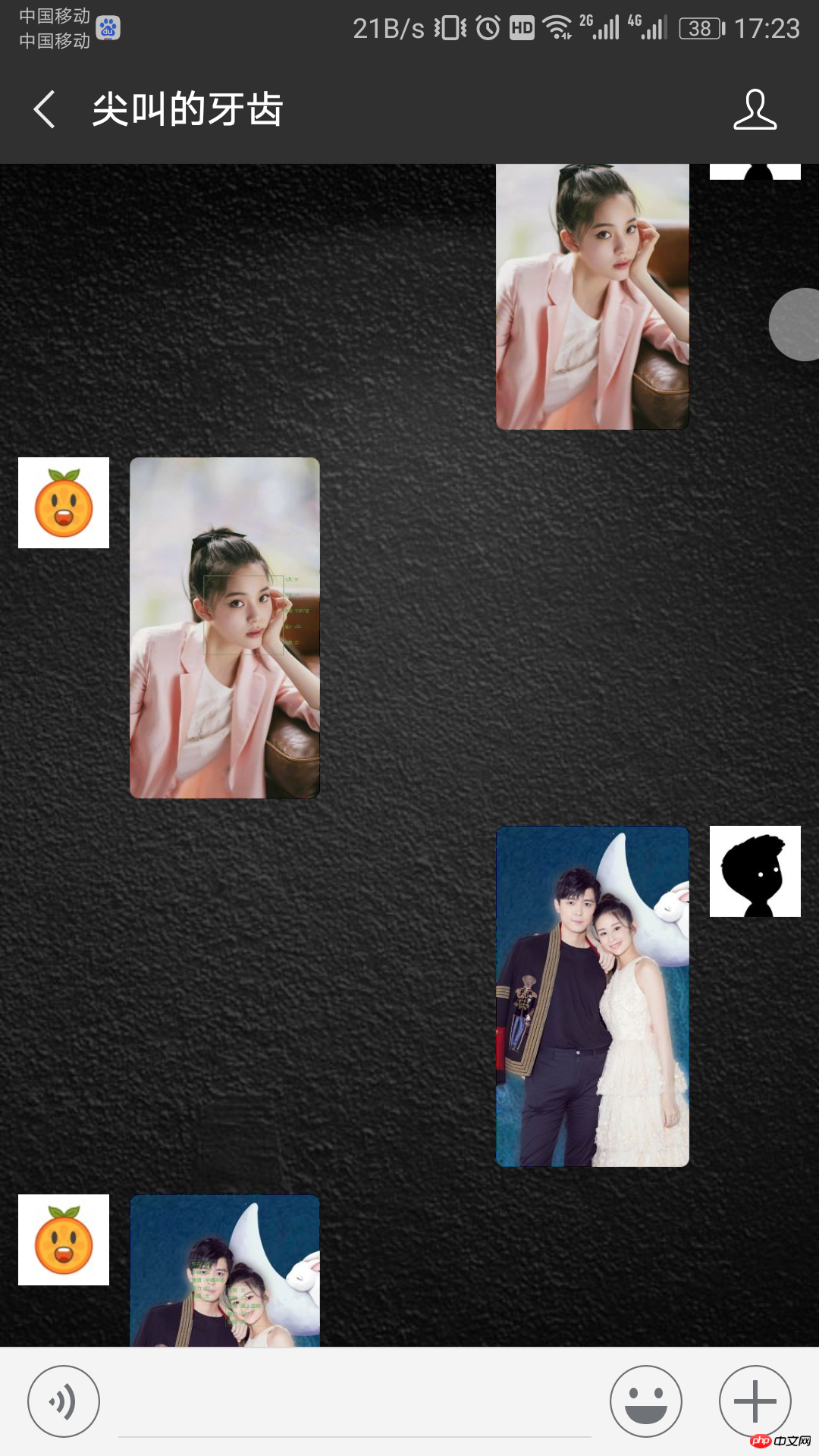來看看你的顏值多高吧!基於Python開發的公眾號
這是一個基於Python的微信公眾號開發之顏值檢測,今天我們把用戶的圖片通過騰訊的AI平台分析後再返回給用戶。來一起體驗下公眾號的顏值檢測吧
效果圖



#一. 接入騰訊AI平台
我們先看一下官方人臉偵測與分析介面的描述:偵測給定圖片(Image)中的所有人臉(Face)的位置和對應的臉部屬性。位置包括(x, y, w, h),臉部屬性包括性別(gender), 年齡(age), 表情(expression), 魅力(beauty), 眼鏡(glass)和姿態(pitch,roll,yaw)。
請求參數包含下面幾個:- app_id 應用標識,我們在AI平台註冊後就可以得到app_id
- time_stamp 時間戳記
- nonce_str 隨機字串
- sign 簽章訊息,需要我們自己去計算
#image 需要偵測的圖片(上限1M)
mode 偵測模式
1.介面鑑權,建構請求參數
官方給了我們介面鑑權的計算方法。 - 將
- 將列表N中的參數對按URL鍵值對的格式拼接成字串,得到字串T(如:key1=value1&key2=value2),URL鍵值拼接過程value部分需要URL編碼,URL編碼演算法用大寫字母,例如�,而不是小寫�
將應用金鑰以app_key為鍵名,組成URL鍵值拼接到字串T結尾,得到字串S(如:key1=value1&key2 =value2&app_key=金鑰)
對字串S進行MD5運算,將得到的MD5值所有字元轉換成大寫,得到介面請求簽章
2.請求介面位址請求介面訊息,我們用requests 發送請求,會得到傳回的json 格式的映像資訊
安裝requests。
3.處理回傳的訊息
處理回傳的訊息,把訊息展示在圖片上,再把處理後的圖片儲存。這裡我們用到 opencv ,和 pillow 兩個函式庫
pip install pillow和
pip install opencv-python來安裝。
開始寫程式碼,我們新建一個face_id.py 檔案來對接AI平台,並且傳回偵測後的影像資料。
import time
import random
import base64
import hashlib
import requests
from urllib.parse import urlencode
import cv2
import numpy as np
from PIL import Image, ImageDraw, ImageFont
import os
# 一.计算接口鉴权,构造请求参数
def random_str():
'''得到随机字符串nonce_str'''
str = 'abcdefghijklmnopqrstuvwxyz'
r = ''
for i in range(15):
index = random.randint(0,25)
r += str[index]
return r
def image(name):
with open(name, 'rb') as f:
content = f.read()
return base64.b64encode(content)
def get_params(img):
'''组织接口请求的参数形式,并且计算sign接口鉴权信息,
最终返回接口请求所需要的参数字典'''
params = {
'app_id': '1106860829',
'time_stamp': str(int(time.time())),
'nonce_str': random_str(),
'image': img,
'mode': '0'
}
sort_dict = sorted(params.items(), key=lambda item: item[0], reverse=False) # 排序
sort_dict.append(('app_key', 'P8Gt8nxi6k8vLKbS')) # 添加app_key
rawtext = urlencode(sort_dict).encode() # URL编码
sha = hashlib.md5()
sha.update(rawtext)
md5text = sha.hexdigest().upper() # 计算出sign,接口鉴权
params['sign'] = md5text # 添加到请求参数列表中
return params
# 二.请求接口URL
def access_api(img):
frame = cv2.imread(img)
nparry_encode = cv2.imencode('.jpg', frame)[1]
data_encode = np.array(nparry_encode)
img_encode = base64.b64encode(data_encode) # 图片转为base64编码格式
url = 'https://api.ai.qq.com/fcgi-bin/face/face_detectface'
res = requests.post(url, get_params(img_encode)).json() # 请求URL,得到json信息
# 把信息显示到图片上
if res['ret'] == 0: # 0代表请求成功
pil_img = Image.fromarray(cv2.cvtColor(frame, cv2.COLOR_BGR2RGB)) # 把opencv格式转换为PIL格式,方便写汉字
draw = ImageDraw.Draw(pil_img)
for obj in res['data']['face_list']:
img_width = res['data']['image_width'] # 图像宽度
img_height = res['data']['image_height'] # 图像高度
# print(obj)
x = obj['x'] # 人脸框左上角x坐标
y = obj['y'] # 人脸框左上角y坐标
w = obj['width'] # 人脸框宽度
h = obj['height'] # 人脸框高度
# 根据返回的值,自定义一下显示的文字内容
if obj['glass'] == 1: # 眼镜
glass = '有'
else:
glass = '无'
if obj['gender'] >= 70: # 性别值从0-100表示从女性到男性
gender = '男'
elif 50 <= obj['gender'] < 70:
gender = "娘"
elif obj['gender'] < 30:
gender = '女'
else:
gender = '女汉子'
if 90 < obj['expression'] <= 100: # 表情从0-100,表示笑的程度
expression = '一笑倾城'
elif 80 < obj['expression'] <= 90:
expression = '心花怒放'
elif 70 < obj['expression'] <= 80:
expression = '兴高采烈'
elif 60 < obj['expression'] <= 70:
expression = '眉开眼笑'
elif 50 < obj['expression'] <= 60:
expression = '喜上眉梢'
elif 40 < obj['expression'] <= 50:
expression = '喜气洋洋'
elif 30 < obj['expression'] <= 40:
expression = '笑逐颜开'
elif 20 < obj['expression'] <= 30:
expression = '似笑非笑'
elif 10 < obj['expression'] <= 20:
expression = '半嗔半喜'
elif 0 <= obj['expression'] <= 10:
expression = '黯然伤神'
delt = h // 5 # 确定文字垂直距离
# 写入图片
if len(res['data']['face_list']) > 1: # 检测到多个人脸,就把信息写入人脸框内
font = ImageFont.truetype('yahei.ttf', w // 8, encoding='utf-8') # 提前把字体文件下载好
draw.text((x + 10, y + 10), '性别 :' + gender, (76, 176, 80), font=font)
draw.text((x + 10, y + 10 + delt * 1), '年龄 :' + str(obj['age']), (76, 176, 80), font=font)
draw.text((x + 10, y + 10 + delt * 2), '表情 :' + expression, (76, 176, 80), font=font)
draw.text((x + 10, y + 10 + delt * 3), '魅力 :' + str(obj['beauty']), (76, 176, 80), font=font)
draw.text((x + 10, y + 10 + delt * 4), '眼镜 :' + glass, (76, 176, 80), font=font)
elif img_width - x - w < 170: # 避免图片太窄,导致文字显示不完全
font = ImageFont.truetype('yahei.ttf', w // 8, encoding='utf-8')
draw.text((x + 10, y + 10), '性别 :' + gender, (76, 176, 80), font=font)
draw.text((x + 10, y + 10 + delt * 1), '年龄 :' + str(obj['age']), (76, 176, 80), font=font)
draw.text((x + 10, y + 10 + delt * 2), '表情 :' + expression, (76, 176, 80), font=font)
draw.text((x + 10, y + 10 + delt * 3), '魅力 :' + str(obj['beauty']), (76, 176, 80), font=font)
draw.text((x + 10, y + 10 + delt * 4), '眼镜 :' + glass, (76, 176, 80), font=font)
else:
font = ImageFont.truetype('yahei.ttf', 20, encoding='utf-8')
draw.text((x + w + 10, y + 10), '性别 :' + gender, (76, 176, 80), font=font)
draw.text((x + w + 10, y + 10 + delt * 1), '年龄 :' + str(obj['age']), (76, 176, 80), font=font)
draw.text((x + w + 10, y + 10 + delt * 2), '表情 :' + expression, (76, 176, 80), font=font)
draw.text((x + w + 10, y + 10 + delt * 3), '魅力 :' + str(obj['beauty']), (76, 176, 80), font=font)
draw.text((x + w + 10, y + 10 + delt * 4), '眼镜 :' + glass, (76, 176, 80), font=font)
draw.rectangle((x, y, x + w, y + h), outline="#4CB050") # 画出人脸方框
cv2img = cv2.cvtColor(np.array(pil_img), cv2.COLOR_RGB2BGR) # 把 pil 格式转换为 cv
cv2.imwrite('faces/{}'.format(os.path.basename(img)), cv2img) # 保存图片到 face 文件夹下
return '检测成功'
else:
return '检测失败'到這裡我們的人臉偵測介面存取及圖片處理就完成了。之後在收到用戶傳送的圖片訊息後,呼叫這個函數,把處理後的圖片回傳給用戶就可以。
返回圖片給使用者
當收到使用者圖片時,需要以下步驟:
#儲存圖片#當接收到使用者圖片後,我們要先把圖片保存起來,之後才能去調用人臉分析接口,把圖片資訊傳遞過去,我們需要編寫一個img_download 函數來下載圖片。詳見下方程式碼
呼叫人臉分析介面
圖片下載後,呼叫 face_id.py 檔案裡的介面函數,得到處理後的圖片。
上傳圖片
偵測結果是新的圖片,要把圖片傳送給使用者我們需要一個Media_ID,要取得Media_ID必須先把圖片上傳為暫存素材,所以這裡我們需要一個img_upload函數來上傳圖片,並且在上傳時需要用到一個access_token,我們通過一個函數來獲取.
獲取access_token必須要把我們自己的IP地址加入白名單,否則是獲取不到的。請登入「微信公眾平台-開發-基本配置」提前將伺服器IP位址加入IP白名單中,可以在http://ip.qq.com/查看本機的IP...####### ###開始寫程式碼,我們新建一個utils.py 來下載、上傳圖片###rrreee###回傳給使用者######我們簡單修改收到圖片後的邏輯,收到圖片後經過臉部偵測,上傳獲得Media_ID,我們要做的就是把圖片回傳給使用者即可。直接看connect.py的程式碼###import requests
import json
import threading
import time
import os
token = ''
app_id = 'wxfc6adcdd7593a712'
secret = '429d85da0244792be19e0deb29615128'
def img_download(url, name):
r = requests.get(url)
with open('images/{}-{}.jpg'.format(name, time.strftime("%Y_%m_%d%H_%M_%S", time.localtime())), 'wb') as fd:
fd.write(r.content)
if os.path.getsize(fd.name) >= 1048576:
return 'large'
# print('namename', os.path.basename(fd.name))
return os.path.basename(fd.name)
def get_access_token(appid, secret):
'''获取access_token,100分钟刷新一次'''
url = 'https://api.weixin.qq.com/cgi-bin/token?grant_type=client_credential&appid={}&secret={}'.format(appid, secret)
r = requests.get(url)
parse_json = json.loads(r.text)
global token
token = parse_json['access_token']
global timer
timer = threading.Timer(6000, get_access_token)
timer.start()
def img_upload(mediaType, name):
global token
url = "https://api.weixin.qq.com/cgi-bin/media/upload?access_token=%s&type=%s" % (token, mediaType)
files = {'media': open('{}'.format(name), 'rb')}
r = requests.post(url, files=files)
parse_json = json.loads(r.text)
return parse_json['media_id']
get_access_token(app_id, secret)微信的機制,我們的程式必須在5s內給予回應。不然就會報'公眾號提供的服務故障'。然而處理圖片有時會比較慢,常常會超過5s。所以正確的處理方式應該是拿到用戶的請求後立即返回一個空字符串表示我們收到了,之後單獨創建一個線程去處理圖片,當圖片處理完後通過客服接口發送給用戶。可惜的是未認證的公眾號沒有客服接口,所以沒辦法,超過5s就會報錯。
無法自訂選單,一旦啟用了自訂開發,選單也需要自訂配置,但是未認證的公眾號沒有權限通過程式來配置選單,只能在微信後台配置。
所以,我並沒有在我的公眾號上啟用這個程序,但是如果有認證的公眾號,可以嘗試開發各種好玩的功能。
相關推薦:
以上是來看看你的顏值多高吧!基於Python開發的公眾號的詳細內容。更多資訊請關注PHP中文網其他相關文章!

熱AI工具

Undresser.AI Undress
人工智慧驅動的應用程序,用於創建逼真的裸體照片

AI Clothes Remover
用於從照片中去除衣服的線上人工智慧工具。

Undress AI Tool
免費脫衣圖片

Clothoff.io
AI脫衣器

AI Hentai Generator
免費產生 AI 無盡。

熱門文章

熱工具

記事本++7.3.1
好用且免費的程式碼編輯器

SublimeText3漢化版
中文版,非常好用

禪工作室 13.0.1
強大的PHP整合開發環境

Dreamweaver CS6
視覺化網頁開發工具

SublimeText3 Mac版
神級程式碼編輯軟體(SublimeText3)

熱門話題
 mysql 是否要付費
Apr 08, 2025 pm 05:36 PM
mysql 是否要付費
Apr 08, 2025 pm 05:36 PM
MySQL 有免費的社區版和收費的企業版。社區版可免費使用和修改,但支持有限,適合穩定性要求不高、技術能力強的應用。企業版提供全面商業支持,適合需要穩定可靠、高性能數據庫且願意為支持買單的應用。選擇版本時考慮的因素包括應用關鍵性、預算和技術技能。沒有完美的選項,只有最合適的方案,需根據具體情況謹慎選擇。
 mysql安裝後怎麼使用
Apr 08, 2025 am 11:48 AM
mysql安裝後怎麼使用
Apr 08, 2025 am 11:48 AM
文章介紹了MySQL數據庫的上手操作。首先,需安裝MySQL客戶端,如MySQLWorkbench或命令行客戶端。 1.使用mysql-uroot-p命令連接服務器,並使用root賬戶密碼登錄;2.使用CREATEDATABASE創建數據庫,USE選擇數據庫;3.使用CREATETABLE創建表,定義字段及數據類型;4.使用INSERTINTO插入數據,SELECT查詢數據,UPDATE更新數據,DELETE刪除數據。熟練掌握這些步驟,並學習處理常見問題和優化數據庫性能,才能高效使用MySQL。
 mysql 需要互聯網嗎
Apr 08, 2025 pm 02:18 PM
mysql 需要互聯網嗎
Apr 08, 2025 pm 02:18 PM
MySQL 可在無需網絡連接的情況下運行,進行基本的數據存儲和管理。但是,對於與其他系統交互、遠程訪問或使用高級功能(如復制和集群)的情況,則需要網絡連接。此外,安全措施(如防火牆)、性能優化(選擇合適的網絡連接)和數據備份對於連接到互聯網的 MySQL 數據庫至關重要。
 如何針對高負載應用程序優化 MySQL 性能?
Apr 08, 2025 pm 06:03 PM
如何針對高負載應用程序優化 MySQL 性能?
Apr 08, 2025 pm 06:03 PM
MySQL數據庫性能優化指南在資源密集型應用中,MySQL數據庫扮演著至關重要的角色,負責管理海量事務。然而,隨著應用規模的擴大,數據庫性能瓶頸往往成為製約因素。本文將探討一系列行之有效的MySQL性能優化策略,確保您的應用在高負載下依然保持高效響應。我們將結合實際案例,深入講解索引、查詢優化、數據庫設計以及緩存等關鍵技術。 1.數據庫架構設計優化合理的數據庫架構是MySQL性能優化的基石。以下是一些核心原則:選擇合適的數據類型選擇最小的、符合需求的數據類型,既能節省存儲空間,又能提升數據處理速度
 HadiDB:Python 中的輕量級、可水平擴展的數據庫
Apr 08, 2025 pm 06:12 PM
HadiDB:Python 中的輕量級、可水平擴展的數據庫
Apr 08, 2025 pm 06:12 PM
HadiDB:輕量級、高水平可擴展的Python數據庫HadiDB(hadidb)是一個用Python編寫的輕量級數據庫,具備高度水平的可擴展性。安裝HadiDB使用pip安裝:pipinstallhadidb用戶管理創建用戶:createuser()方法創建一個新用戶。 authentication()方法驗證用戶身份。 fromhadidb.operationimportuseruser_obj=user("admin","admin")user_obj.
 Navicat查看MongoDB數據庫密碼的方法
Apr 08, 2025 pm 09:39 PM
Navicat查看MongoDB數據庫密碼的方法
Apr 08, 2025 pm 09:39 PM
直接通過 Navicat 查看 MongoDB 密碼是不可能的,因為它以哈希值形式存儲。取回丟失密碼的方法:1. 重置密碼;2. 檢查配置文件(可能包含哈希值);3. 檢查代碼(可能硬編碼密碼)。
 mysql workbench 可以連接到 mariadb 嗎
Apr 08, 2025 pm 02:33 PM
mysql workbench 可以連接到 mariadb 嗎
Apr 08, 2025 pm 02:33 PM
MySQL Workbench 可以連接 MariaDB,前提是配置正確。首先選擇 "MariaDB" 作為連接器類型。在連接配置中,正確設置 HOST、PORT、USER、PASSWORD 和 DATABASE。測試連接時,檢查 MariaDB 服務是否啟動,用戶名和密碼是否正確,端口號是否正確,防火牆是否允許連接,以及數據庫是否存在。高級用法中,使用連接池技術優化性能。常見錯誤包括權限不足、網絡連接問題等,調試錯誤時仔細分析錯誤信息和使用調試工具。優化網絡配置可以提升性能
 mysql 需要服務器嗎
Apr 08, 2025 pm 02:12 PM
mysql 需要服務器嗎
Apr 08, 2025 pm 02:12 PM
對於生產環境,通常需要一台服務器來運行 MySQL,原因包括性能、可靠性、安全性和可擴展性。服務器通常擁有更強大的硬件、冗餘配置和更嚴格的安全措施。對於小型、低負載應用,可在本地機器運行 MySQL,但需謹慎考慮資源消耗、安全風險和維護成本。如需更高的可靠性和安全性,應將 MySQL 部署到雲服務器或其他服務器上。選擇合適的服務器配置需要根據應用負載和數據量進行評估。






